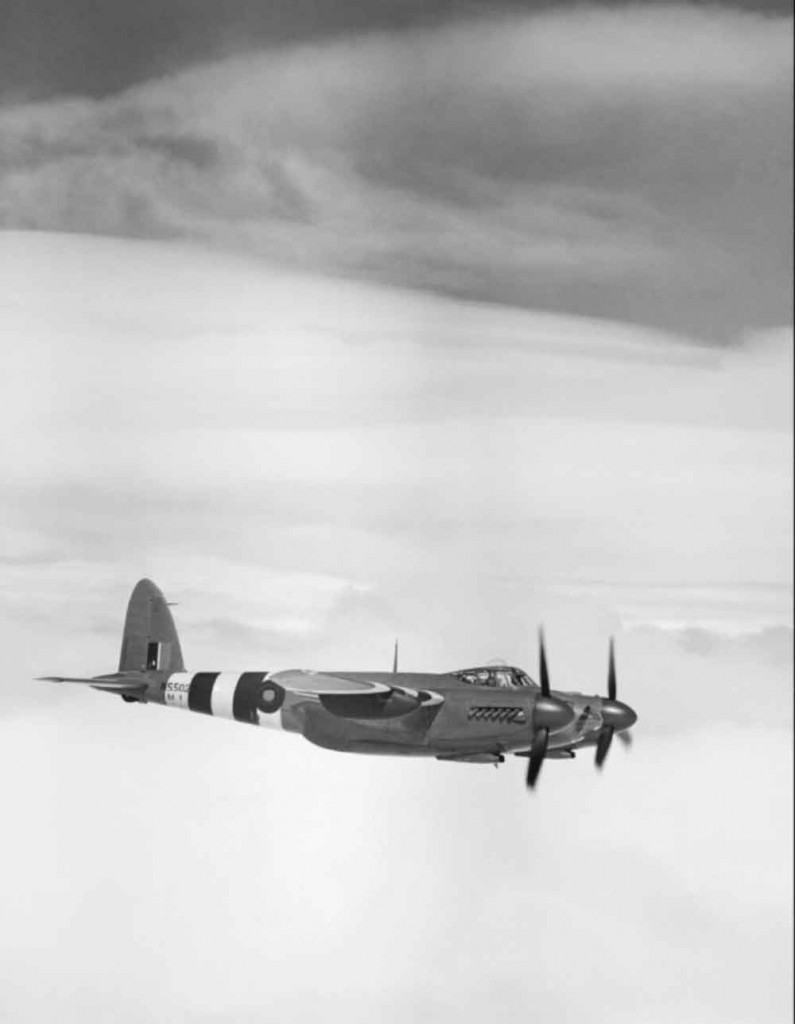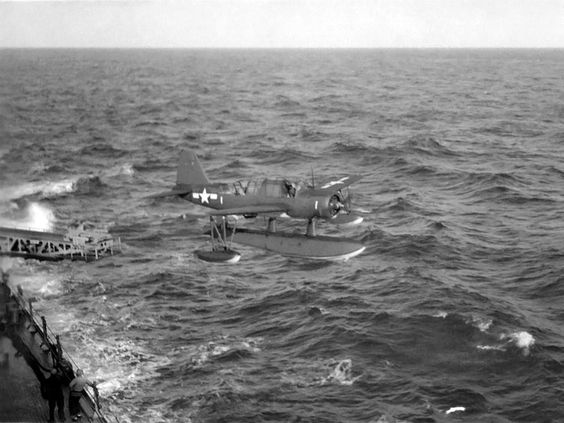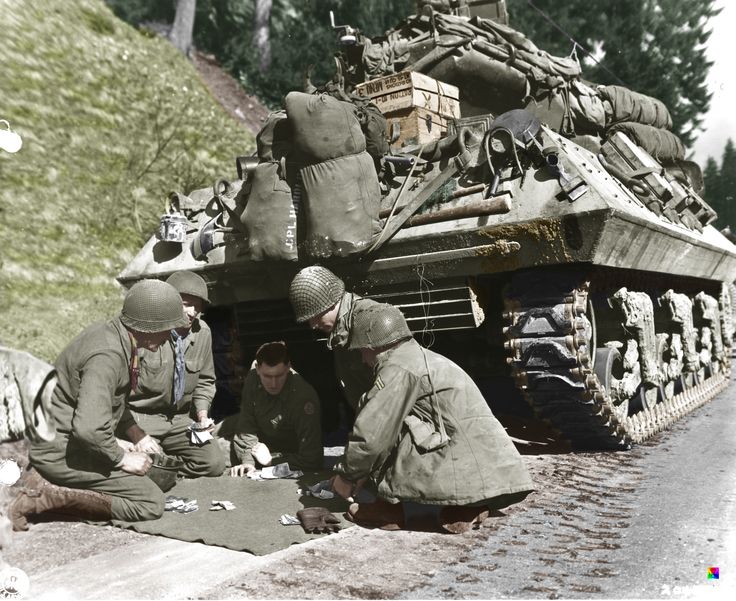Air Operations, CBI
BURMA- More than 60 10th Air Force fighter-bombers attack troops, stores, and targets of opportunity at 10 locations.
- 28 P-47s attack bridges at 6 locations.
- 8 P-47s support Allied ground forces near Bhamo.
- 14th Air Force B-25s attack bridges at Kutkai, Lashio, and Namhkai.
- 341st Medium Bomb Group B-25s attack bridges and road, river, and rail traffic at Hsiangcheng, Kweilin, Lingling, Saiping, and in several other areas.
- More than 90 14th Air Force fighter-bombers attack targets of opportunity in southern China, northern Burma, and northern French Indochina.
- 118th Tactical Reconnaissance Squadron P-51s down 4 Ki-43 'Oscar' fighters over Ehr Tao Kow airfield at Chiuchiang during an afternoon engagement.
Air Operations, Europe
Air raids against V-2 launch sites destroy only 2 rockets, but prompt the Germans to limit launches to the night hours.
RAF BOMBER COMMANDDaylight Ops:
- 160 Lancasters of No. 3 Group carry out a G-H raid on Oberhausen, but results are unknown because of cloud.
- 1 Lancaster is lost.
- 27 Lancasters and 3 Mosquitos of No. 8 Group carry out the first of several raids on the large reservoir dam at Urft in the Eifel. The destruction of which is required so that the Germans can not release water to flood areas through which American troops wish to advance. The series of raids did blast 13ft off the top of the dam but no large breach is ever made and the Germans are able to release large quantities of water whenever they wish to interfere with American advances being attempted further downstream.
- No aircraft are lost on this raid.
- 369 Lancasters, 154 Halifaxes and 12 Mosquitos of Nos. 1, 6 and 8 Groups are sent to attack Karlsruhe. The marking and bombing are accurate and severe damage is caused, particularly in the southern and western districts of the city. Among individual buildings destroyed are the important Durlacher machine-tool factory, the main Protestant church and the concert hall.
- 1 Lancaster and 1 Mosquito are lost.
- 282 Lancasters and 10 Mosquitos of No. 5 Group are sent to attack Heilbronn east of Karlsruhe. This is a crushing blow on Heilbronn which stands on a main north-south railway line but is otherwise of little importance. It is the first and only major raid by Bomber Command on this target. 1,254 tons of bombs fall in a few minutes and the post-war British Bombing Survey Unit estimates that 351 acres, 82 per cent of the town's built-u6p area, are destroyed, mainly by fire. Much investigation by various people result in the reliable estimate that just over 7,000 people died. Most of these victims die in fires so intense that there was probably a genuine firestorm. For the bombers, there are numerous battles with German night fighters.
- 12 Lancasters are lost on the raid.
- 54 Mosquitos are sent to Hagen, 12 to Bielefeld and Hamm, and there are 60 Mosquito patrols and 47 RCM sorties.
- There are no losses.
GERMANY:
- 188 of 419 1st Bomb Division B-17s dispatched attack marshalling yards at Kassel and Soest.
- 199 2nd Bomb Division B-24s attack a marshalling yard at Bebra.
- 99 2nd Bomb Division B-24s attack marshalling yards at Giessen and Koblenz (targets of opportunity).
- 221 3rd Bomb Division B-17s attack a marshalling yard at Mainz.
- 62 3rd Bomb Division B-17s attack a marshalling yard at Giessen.
- 119 3rd Bomb Division B-17s attack a marshalling yard at Friedburg (target of opportunity.
- 41 3rd Bomb Division B-17s attack various targets of opportunity.
- 3 heavy bombers and 3 of 939 VIII Fighter Command escorts are lost.
GERMANY:
- 9th Air Fokrce fighters support US Army ground forces in western Germany.
ITALY:
- 12th Air Force B-24s attak an ammo dump and two defended towns.
- XXII TAC P-47s support the US 5th Army and attack lines of communication.
YUGOSLAVIA:
- 26 15th Air Force P-38s bomb a rail bridge.
Burma
Gen William Slim, commander of the British 14th Army, begins the destruction of Japanese forces in Burma. The British IV and XXXIII Corps begin the offensive, heading for the Japanese airfields at Yeu and Shwebo. The Japanese 15th Army, commanded by Gen Shihachi Katamura, is in a weakened state following its reverses during the fighting at Kohima and Imphal. The British establish 3 bridgeheads on the Chindwin River as part of Operation EXTENDED CAPITAL. XXXIII Coprps will drive southeast toward Schewbo and Mandalay in a two-pronged attack. In the south, IV Corps will push down the Kabbaw Valley aiming toward Tilin and Pakokku, roughly 100 miles southwest of Mandalay itself. In the far north, the 19th Indian Div begins a decoy offensive out from Sittaung toward Indaw.
[China
Gen Albert C. Wedemeyer requests that all B-29s be removed form their China bases because of the difficulty of supplying them by air over the hump.
[Eastern Front
Fighting continues northeast and southwest of Budapest. Mitrovica falls to the Russians.
SOUTHERN SECTORThe 2nd Ukrainian Front begins an attack with its 47th Army aimed at crossing the Danube at Ercsi. Attacking just before midnight the Soviet force meets overwhelming German counter-fire and is repulsed with massive losses.
[Italy
In the British 8th Army sector the Polish II Corps takes Montecchio, while units of the Canadian I Corps enter Ravenna.
[Pacific
- The US destroyer Drayton (DD-366) is damaged by a Japanese bomber in the Leyte area of the Philippine Islands.
- The US submarine Flasher (SS-249) sinks two Japanese destroyers, the Kishinami and the Iwanami, in the South China Sea.
Philippines
The US 7th Air Force begins a series of night raids against Japanese airfields on the island of Luzon. On Leyte, in the US X Corps sector, the 112th Cavalry renews its attacks on Japanese positions southeast of Limon, but without success. Other units, from the 24th Div, withdraw from Kilay Ridge toward Pinamopoan. The XXIV Corps prepares for the offensive against Ormoc; the 7th Div will advance along the coast and the 77th Div will carry out an amphibious operation, landing in Ormoc Bay.
[Western Front
The XIII Corps, US 9th Army, breaks off its offensive after taking all its objectives west of the Rur except the villages of Wurm and Müllendorf.
In the American 1st Army sector the 104th Div reinforces its bridgehead over the Inden River. To take advantage of the capture of the bridge over the Saar at Saarlautern, northwest of Saarbrücken, the 95th Div of the XX Corps, 3rd Army, quickly regroups and sends several units across the river, where they begin a hard struggle for the capture of the outskirts of Fraulautern, which forms part of the Siegfried Line, the West Wall.
The XII Corps opens the final assault on the Saar and the Siegfried Line with its 4 divisions, the 80th, 6th Arm, 35th and 26th; the 104th Regt of this latter division eliminates the last centers of resistance at Saar-Union.
The British 2nd Army eliminates the last German bridgehead west of the Maas.
[Images from December 4, 1944
|
|
|
|



